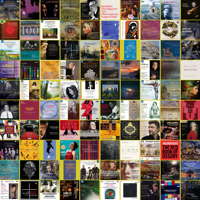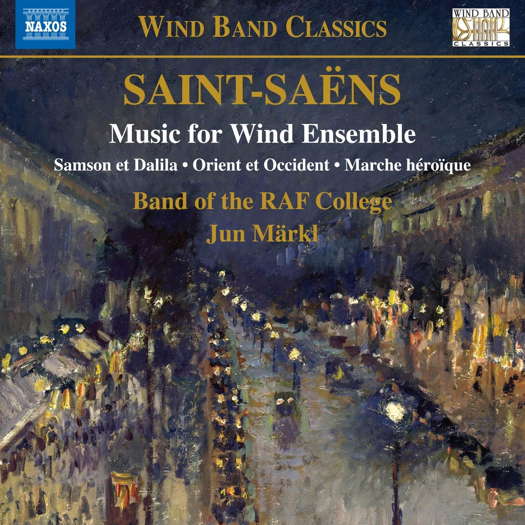 UPDATES: There's a new feature every day at Classical Music Daily. Read about the various ways we can keep in touch with you about what's happening here.
UPDATES: There's a new feature every day at Classical Music Daily. Read about the various ways we can keep in touch with you about what's happening here.

On the March
Saint-Saëns wind music, enjoyed by GERALD FENECH
'... a truly glorious Saint-Saëns anthology wrapped in a different soundscape ...'
Camille Saint-Saëns, one of the greatest composers of the French Romantic period, was born on 9 October 1835 in Paris. Soon after the christening of the child, his father Victor died of consumption on the first anniversary of his marriage. The young Camille was taken to the country for the sake of his health, and for two years lived with a nurse at Corbell, twenty-nine kilometres to the south of Paris. When the boy was brought back to Paris he lived with his mother and her widowed aunt. Before he was three he displayed perfect pitch and enjoyed picking out tunes on the piano. Hardly an encouraging start for a fledgling young being that was to become a truly great composer. But let us move on.
A child prodigy, Saint-Saëns began to compose at the age of seven, and made his pianistic debut at the Salle Pleyel in 1846 aged ten. A few years later he studied organ and composition at the Paris Conservatoire. His first symphony was performed in December 1853. For the next four years he was organist at Saint-Merry Church in Paris before moving on to the Madeleine, a most prestigious post from which he resigned in 1857.
The composer thereafter devoted himself to composition and conducting while still making concert appearances as pianist and organist. He taught piano at the Ecole Niedemeyer, numbering Gabriel Fauré among his students. In 1875 he married Marie Truffot but the marriage was a disaster, and they separated in 1881.
Over the years Saint-Saëns received many honours from various countries, among which were Honorary Doctorates from Oxford and Cambridge Universities, while in France he became a Chevalier of the Legion of Honour. The composer, although a renowned recluse, loved travelling, and he first visited America in 1906 aged seventy-one. In 1916 he toured South America, and in May 1920 he took part in a festival in Athens as conductor and pianist. In August 1921 he performed a piano recital of his own pieces at the Dieppe Museum. He died on 16 December 1921, aged eighty-six.
The composer's output was most prolific, and it covers every aspect of French music. His frequent travels led to a fascinating mixture of Western music with Moorish and African elements in works such as Orient et Occident and the Suite algerienne, from which a respective march can be heard on this recording. Saint-Saëns wrote few works for winds, so this issue is more than welcome, as, despite the arrangements by several eminent musicians, the composer's gift for melody and harmonic subtlety are brought out with unblemished clarity. At this point, I think it would be most fitting to insert in this review 'tiny vignettes' of information on each of the pieces included in this recording. After all, 2021 is the centenary of the composer's death, so let us proceed.
- Orient et Occident, Op 25 (1869)
Composed for a gala evening of the Union Centrale des Beaux-Arts in October 1869 featuring an oriental art exhibition, this piece was dedicated to Theodore Biais, a friend of the composer and manufacturer of church ornaments. It was the first of four original works that Saint-Saëns composed for military band. Subtitled as a 'Grand March', the piece includes contemporary characteristics of Eastern and Western styles. The opening is typical of Western music whilst the central section brings together the Oriental with North African and Middle Eastern atmospherics and Moorish rhythms. In the grand finale a brief fugue on the original theme emphasizes again images of Western music mixed with echoes of Oriental moods. - Samson et Dalilah, Op 47 a) Dance of Dagon's Priestesses (Act 1), b) Bacchanale (Act 3) (1877)
First staged in 1837, Samson et Dalilah is undoubtedly the composer's most popular opera among the twelve he wrote. The story follows the main events of the Biblical narration. The Priestesses' dance is taken from Act 1 at a point when Dalilah emerges from the Temple of Dagon with her entourage. She attempts to seduce Samson into going to her home in the Valley of Sorek, after the Jewish hero had killed Abimelech, the Philistine Governor, with his sword. At this point the dance of the priestesses takes place, presenting exotic themes of enticing rhythmic charms with occasional sinister undertones. The famous Bacchanale appears in Act 3 just before Samson brings Dagon's Temple tumbling down on the Philistines, killing all including himself. This ritual sequence is derived from Bacchus, the god of wine and debauchery. A number of melodies are introduced in this riotous piece evoking the mystic East as well as other evocative themes. - Marche héroïque, Op 34 (1870)
Written during the Siege of Paris (1870-71), this work was dedicated to the memory of Henri Regnault, a painter killed on 19th January 1871 in battle during the Franco-Prussian War. It opens with a vigorous uplifting march at a brisk tempo, after which the excitement decreases and a quieter mood of remembrance sets in. After exploring these new colours, a recapitulation of the opening theme with a coda brings this piece to a rousing end. - Marche militaire française from Suite algerienne, Op 60 (1880)
This is the fourth movement of a symphonic poem influenced by the composer's visit to Algeria, then a French colony. Once again Saint-Saëns favours a fast tempo for his climactic 'Marche', with more emphasis on the French military tradition than the exotic elements of Algerian musical culture. Brief notes by the composer for each movement provide the key to the work. Thus the guide to the last movement: 'In the colourful bazaars and Moorish cafes of Algeria the quick march of a French regiment is heard, its warlike strains contrasting with the bizarre rhythms and languid melodies of the East.' - Pas redoublé, Op 86 (1887)
This concert march in quick step was originally for piano four hands (1887) and published in 1890. During the nineteenth century the military pace of marching varied from ninety steps per minute for the slow march (pas ordinaire), 120 steps for the quick march (pas redoublé) and above 160 for the double quick march (pas de charge). - Vers la victoire, Op 152 (1917)
Written in 1917 (originally for piano four hands), and subtitled 'pas redoublé pour musique militaire', towards the end of the First World War, this is a patriotic piece composed in the fervent belief that victory would be attained after so many years of bloodshed. At the time of writing Saint-Saëns was over eighty years old. - Marche religieuse, Op 107 (1897)
In November 1897 Saint-Saëns performed an organ recital for Queen Marie Christine of Spain in the Church of San Francisco in Madrid. One of the pieces performed was this Marche religieuse which left a great impression on the Queen. Indeed, it was published the following year and dedicated to Her Majesty. The composition begins in hymn-like mode before evolving into more complex contrapuntal writing and some intricate passages. It is a virtuosic piece and it is believed that it was last played by Saint-Saëns in his last public organ recital at the Salle Gaveau on 6 November 1913. - 'Introduction et Marche royale du Lion' from Le Carnaval des Animaux (1886)
The Carnival of the Animals is a light-hearted Suite in fourteen movements, originally written for private performance when Saint-Saëns was in an Austrian village. With the exception of 'The Swan', the work was never published in the composer's lifetime as he did not consider it serious enough. The characterization of the 'Royal March of the Lion' is vivid. After a brief introduction, the regal parade begins with repeated notes progressing to roaring sounds in the bass area of the ensemble. It is a delightful concept, superbly evocative and with aspects of appropriate and memorable humour. - Marche du Couronnement, Op 117 (1902)
This 'Coronation March' was written for the Coronation of Edward VII in 1902. Thus Saint-Saëns, though French, joined the eminent group of composers commissioned to celebrate twentieth century British coronations - among them Elgar, Bax, Walton and Bliss. It is an appropriate stirring and dignified March, full of flourishes and grandeur. - Henry VIII - Act 2: 'Ballet Divertissement' (1882)
Henry VIII is a four-act opera first staged at the Paris Opera on 5 March 1883. It also featured at the 1889 Paris Exhibition. The opera deals with the proposed marriage of Henry VIII and Anne Boleyn. The four ballet movements are magnificently picturesque and require little in the way of introduction. The composer's perspectives on English and Scottish dances are fascinating and brilliantly imaginative in their unique Gallic style.
Listen — Saint-Saëns, arr Timothy Reynish and Bruce Perry:
Grande Marche (Orient et Occident)
(track 1, 0:00-0:54) ℗ 2021 Naxos Rights (Europe) Ltd :
Listen — Saint-Saëns, arr Leigh D Steiger: Bacchanale (Samson et Dalilah)
(track 2, 0:58-1:57) ℗ 2021 Naxos Rights (Europe) Ltd :
Listen — Saint-Saëns, arr Auguste Josneau: Pas redoublé
(track 6, 0:00-0:54) ℗ 2021 Naxos Rights (Europe) Ltd :
Listen — Saint-Saëns, arr Mike Parsons:
Introduction et Marche royale du Lion (Le Carnaval des Animaux)
(track 9, 0:49-1:31) ℗ 2021 Naxos Rights (Europe) Ltd :
Listen — Saint-Saëns, arr Louis-Philippe Laurendeau:
Danse de la Gipsy (Henry VIII Act II ballet)
(track 13, 1:51-2:34) ℗ 2021 Naxos Rights (Europe) Ltd :
This is a truly glorious Saint-Saëns anthology wrapped in a different soundscape that reveals the music in a new, quasi brassy light. Spectacular performances coupled with some gorgeous sound quality complete a peach of a disc that keeps you on the march from beginning to end. So let your hair down and just join in.
Copyright © 17 February 2021
Gerald Fenech,
Gzira, Malta

CD INFORMATION - SAINT-SAËNS: MUSIC FOR WIND ENSEMBLE
MORE ARTICLES ABOUT CAMILLE SAINT-SAËNS



